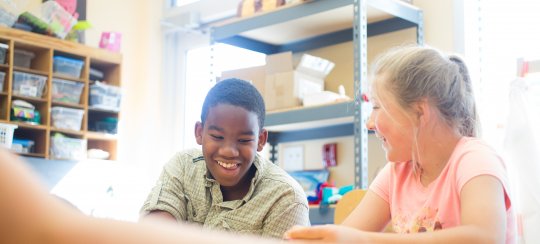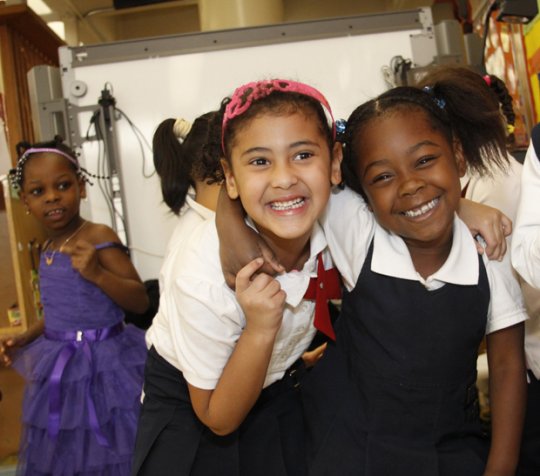Unit 4: Lesson 13
Put It All Together Rehearsal for Seedfolks Composition; TRAIL Marker #3
LITERACY OBJECTIVE
By the end of this lesson students will be able to reflect on their music choices and how they represent the text.
LITERACY "I CAN" STATEMENT
"I can reflect on my music choices and how they represent the text."
LESSON OVERVIEW
| Steps: |
Pacing: 60 minutes |
|
|
10-15 Minutes |
|
|
30 Minutes |
|
|
10-15 Minutes |
Reading Standards (Informational Text)
RL 3.2: Recount stories, including fables, folktales, and myths from diverse cultures; determine the central message, lesson, or moral and explain how it is conveyed through key details in the text.
Writing & Language
W 4.9a: Apply grade 4 Reading standards to literature (e.g., “Describe in depth a character, setting, or event in a story or drama, drawing on specific details in the text [e.g., a character’s thoughts, words, or actions].”).
W 5.4: Produce clear and coherent writing in which the development and organization are appropriate to task, purpose, and audience.
W 5.9a: Apply grade 5 Reading standards to literature (e.g., “Compare and contrast two or more characters, settings, or events in a story or a drama, drawing on specific details in the text [e.g., how characters interact]”).
Speaking & Listening
SL 3.1a: Come to discussions prepared, having read or studied required material; explicitly draw on that preparation and other information known about the topic to explore ideas under discussion.
SL 3.1b: Follow agreed-upon rules for discussions (e.g., gaining the floor in respectful ways, listening to others with care, speaking one at a time about the topics and texts under discussion).
SL 3.1c: Ask questions to check understanding of information presented, stay on topic, and link their comments to the remarks of others.
SL 3.1d: Explain their own ideas and understanding in light of the discussion.
SL 3.2: Determine the main ideas and supporting details of a text read aloud or information presented in diverse media and formats, including visually, quantitatively, and orally.
SL 3.3: Ask and answer questions about information from a speaker, offering appropriate elaboration and detail.
SL 3.6: Speak in complete sentences when appropriate to task and situation in order to provide requested detail or clarification.
SL 4.1a: Come to discussions prepared, having read or studied required material; explicitly draw on that preparation and other information known about the topic to explore ideas under discussion.
SL 4.1b: Follow agreed-upon rules for discussions and carry out assigned roles.
SL 4.1c: Pose and respond to specific questions to clarify or follow up on information, and make comments that contribute to the discussion and link to the remarks of others.
SL 4.1d: Review the key ideas expressed and explain their own ideas and understanding in light of the discussion.
SL 4.2: Paraphrase portions of a text read aloud or information presented in diverse media and formats, including visually, quantitatively, and orally.
SL 4.3: Identify the reasons and evidence a speaker provides to support particular points.
SL 4.6: Differentiate between contexts that call for formal English (e.g., presenting ideas) and situations where informal discourse is appropriate (e.g., small-group discussion); use formal English when appropriate to task and situation.
SL 5.1a: Come to discussions prepared, having read or studied required material; explicitly draw on that preparation and other information known about the topic to explore ideas under discussion.
SL 5.1b: Follow agreed-upon rules for discussions and carry out assigned roles.
SL 5.1c: Pose and respond to specific questions by making comments that contribute to the discussion and elaborate on the remarks of others.
SL 5.1d: Review the key ideas expressed and draw conclusions in light of information and knowledge gained from the discussions.
SL 5.2: Summarize a written text read aloud or information presented in diverse media and formats, including visually, quantitatively, and orally.
SL 5.3: Summarize the points a speaker makes and explain how each claim is supported by reasons and evidence.
SL 5.6: Adapt speech to a variety of contexts and tasks, using formal English when appropriate to task and situation.
W 3.4: With guidance and support from adults, produce writing in which the development and organization are appropriate to task and purpose.
W 3.10: Write routinely over extended time frames (time for research, reflection, and revision) and shorter time frames (a single sitting or a day or two) for a range of discipline-specific tasks, purposes, and audiences.
W 4.4: Produce clear and coherent writing in which the development and organization are appropriate to task, purpose, and audience.
W 4.10: Write routinely over extended time frames (time for research, reflection, and revision) and shorter time frames (a single sitting or a day or two) for a range of discipline-specific tasks, purposes, and audiences.
W 5.10: Write routinely over extended time frames (time for research, reflection, and revision) and shorter time frames (a single sitting or a day or two) for a range of discipline-specific tasks, purposes, and audiences.
L 3.1: Demonstrate command of the conventions of standard English grammar and usage when writing or speaking.
L 3.2: Demonstrate command of the conventions of standard English capitalization, punctuation, and spelling when writing.
L 4.1: Demonstrate command of the conventions of standard English grammar and usage when writing or speaking.
L 4.2: Demonstrate command of the conventions of standard English capitalization, punctuation, and spelling when writing.
L 5.1: Demonstrate command of the conventions of standard English grammar and usage when writing or speaking.
L 5.2: Demonstrate command of the conventions of standard English capitalization, punctuation, and spelling when writing.
Teaching Resources
-Music Instruments and Stations
Unit 4 includes the following Life & Learning Skills:
-Reflective thinking
-Creative problem-solving
-Critical and analytic thinking
-Collaboration Communication
 Differentiation Options
Differentiation Options
Differentiation Options will appear throughout the unit to suggest ways to scaffold or challenge student learning. Use the number of helping hands to select the level of differentiation that best supports student learning.


 Highest level of scaffolding. Select this option if students are learning strategies for the first time, if the text is challenging for them, or if students require more guidance during activities. Part 1 lessons are written for the highest level of scaffolding.
Highest level of scaffolding. Select this option if students are learning strategies for the first time, if the text is challenging for them, or if students require more guidance during activities. Part 1 lessons are written for the highest level of scaffolding.

 Moderate scaffolding. Select this option if students require some support comprehending the text or navigating the activity.
Moderate scaffolding. Select this option if students require some support comprehending the text or navigating the activity.

Least amount of scaffolding/Extending the instruction. Select this option if students are ready to work more independently, move more quickly through the material, or are ready for additional challenge.
 Leveraging Moments
Leveraging Moments
Key instructional steps where the arts are used to leverage literacy-learning (and vice versa) are marked with  . Smaller leveraging moments also occur throughout the lessons.
. Smaller leveraging moments also occur throughout the lessons.
Process: Tell students that in the next two lessons, they get to put together and rehearse their Seedfolks Composition, which they will present to an audience. They will spend time planning, rehearsing, reflecting, refining, and then performing for an audience.
Alternative for using Visual Arts as the Art Form
Students will present their visual art compositions in their school, exhibited with a written statement that articulates their decisions about the theme of the text and explains the text-to-text connections. The written statement may be separate or incorporated into the composition. Students may also be asked to speak to an audience or to those attending the exhibit and to verbally explain their work.
Alternatives Perform & Inform Audiences
Students could perform for many types of audiences, such as:
- Another class also studying this unit. This is a wonderful way for students to see the similarities and differences among Central Themes and Compositions, generated from the same Arts for Learning material. NOTE: If these classes perform for each other, it is best to follow the outline of this lesson as written. Performers will perform best if their final run-through is just prior to their performance.
- Another class (younger, buddy, grade level team)
- Whole school assembly
- Friends and family (day or night)
- Family Fun Art Night
- Expeditionary Night
Process: Give an overview of the lesson objectives: Organize and rehearse themes for the Seedfolks Composition performance; reflect on learning through TRAIL Marker #3.
Suggested Dialogue
"By the end of today's lesson, you will be able to say, 'I can reflect on my music choices and how they represent the text'."
Process: Transition to music, gather instruments, and move to sit in Seedfolks Ensembles. Tell students to wait for the "Go" signal to begin moving.
Suggested Dialogue
"When I play the 'Go' signal, gather your instrument, and move to your Seedfolks Ensembles." (Play "Go" signal. Students gather instruments and move to sit with groups.)
Process: Tell ensembles to run through their themes at least three times, so that they can play it the same way each time. Timing for rehearsal is 8 minutes.
Process: Guide students in combining all elements of the Seedfolks Composition into the rondo form. Create a visual representation of the rondo form for this composition: A for the Seedfolks theme, and B through F (or beyond) for their respective characters' themes. Represent the characters in the order they appear in the book. For example, B=Kim, C=Ana, D=Wendell, E=Gonzalo, etc.
If there is more than one theme for a character, each theme will play in succession in the performance. Prior to this session decide how to determine the performance order. This can be done using a choice method common in your classroom, such as drawing straws. A second possibility is by class discussion: listening to the themes for each character and discussing if there is an artistic reason for one to go first or second. The latter option is more time consuming (about 5-7 minutes per character) yet further deepens the literacy/music connection. See menu below for suggestions.
There may be a single instrument that more than one student plays during the course of the Seedfolks Composition. Let students know that each will have the instrument when needed. Step in to help if needed.
Introduce the teacher's role as conductor, with the conductor facing the musicians. Set up the performance positions: students will be in a semi-circle, with the A-Theme ensemble to teacher's far left. Ensembles B, C, D, E, F, etc. will be arranged consecutively along the line of the semi-circle. Introduce and practice conducting cues. Lead ensembles in several initial run-throughs of the composition, practicing standing at ready with instruments in hand, hands up and apart, and using the conductor's signals to begin playing.
As conductor, it is important to know how each theme begins and ends. Make copies of each ensemble's
Graphic Notation Chart. Student Notebook,
pages 25-26 Stop as needed to add additional notes, for instance, who starts each theme and who ends it. Some ensembles will have evolved to have their own student leader. Regardless, cue the beginning of the theme; let the student conductor take over after that.
Designate where students place instruments after finishing playing their theme. This could be holding them at their sides, placing them on long tables, or on the floor.
Timing for putting it all together is 25 -30 minutes. If leading a class discussion regarding order of multiple themes for one character, add 5-7 minutes per character.
Teaching Tip: Choosing Order of Characters with Multiple Themes
If you have multiple themes for one character, choose the order of the characters' themes by:
1. A method of choice common in your classroom, e.g., drawing straws, numbers between 1-10, or Rock, Paper, Scissors.
OR
2. Leading a class discussion.
- Listen to the ensembles whose are assigned to play that character's theme. Say, "We are going to listen to the ensembles that have been assigned Ana to determine which we want to go first and which we want to go second. This is not about which is better. It's about choosing an order that best reflects the character of Ana, her feelings and transition throughout the chapter."
- Recalling what students know about that character, solicit opinions on which should go first or second. Say, "What do we know about Ana?" (Students respond: She was angry at the beginning." "Later she was regretful.") Ask, "Which order best demonstrates Ana's anger at the beginning and her regret at the end?" (Students respond: 2nd Ana sounded stronger or more angry. 1st Ana was quieter, so it might better reflect her contemplation at the end.") Students might then choose to have the stronger sounding theme play first. Have a class-wide vote to determine the outcome. This is an open-ended process with no "correct" answers. Take the role of guide - not arbiter of taste. Focus on reasons and reflections.
- Repeat the process with the next character that has multiple themes.
Teaching Tip: Conducting Cues
General Guidelines: Use large, firm hand gestures. Think ahead and anticipate entrances. Make eye contact with at least one musician in the ensemble about to play.
This will usually be the natural leader of the group, or the first person who plays.
"Get Ready" & "Go" Signals: To get students ready to play their theme, make an initial "backwards J" movement. This helps musicians anticipate their entrance. Signal ensembles to begin playing their themes by making a straight downward motion. The two movements flow smoothly without stopping. Tell students to come in when your hand returns to the lowest level. When first practicing these signals with students, it is helpful to include the verbal cues, "And . . . now." Say, "And . . ." as the hand is moving upwards; say, "Now" when the hand returns to its starting position.
"Bow" cue: Hold hand up in the air. When all students are watching, silently use fingers to count "one, two, three." On beat four, open palm and arm makes downwards motion as conductor bows. Students bow with conductor. To practice with verbal aid, say, "One, two, three, bow . . ."
Suggested Dialogue
Move students into performance positions
"Now we are ready to put all the pieces together in the rondo form. First, let's look at a visual picture of our composition. A is the Seedfolks Theme. The rest of the themes are organized in the order characters appear in the book." (Create together and display visual picture for Seedfolks Composition, showing which character's theme(s) will be section B, section C, etc.)
For character with multiple themes, choose the order for performance
"We need to decide which Kim theme goes first."
"We are going to do this by (state standard class method-of-choice or class discussion. If class discussion, look at pulldown "Choosing Order of Character Themes." If there is more than one theme for a character, mark this on the visual picture, i.e., Kim-1, Kim-2.) It will be easiest to play in the correct order if we are organized in this sequence. We'll stand in a semicircle. Raise your hand if you are in Ensemble A. Ensemble A will stand here. (Indicate position of Ensemble A. Continue to show placement for Ensembles B-G.) When you hear the "Go" signal, please take your instruments and silently and safely move to your designated spot. When you are in position, place your instruments "At rest." Ready?" (Use "Go" and "Freeze" signals.)
"This will be our set up for both rehearsing and performing our Seedfolks Composition."
Determine if instruments need to be shared during performance
"Are there any instruments that are played in more than one theme?"
"If yes, please raise your hand. (Students raise hands and identify instruments that are shared.) We need to figure out how to get the instruments to the players that need them. During our run-throughs, when you are finished with an instrument that another student needs, get that instrument to the student. You might, for instance, meet each other halfway. If you are playing the Seedfolks Theme A, the instrument will need to come back to you. I know we can work it out."
Introduce & practice conducting cues
"During our rehearsals and performance, I will have the role of conductor."
"Does anyone know what a conductor of an orchestra, choir, or band does? (Students may respond "Keeps everyone together," "Tells people when to start and stop," or "Tells them how to sound better.") As your conductor, I will cue you when it's time for you to begin your theme. Ensembles, stand "at ready" with your instruments in hand, hands up and apart, like this. (Demonstrate.) To show you when to play your theme, I'll give you this signal." (Demonstrate hand going up and down.) When my hand goes up and returns to this place, start your theme. To help you, I'll give you verbal cues with these hand signals, like this: "And . . . now." (Demonstrate hand signal and verbal cue together.)
"Let's practice. When I give the signal to play and say 'And . . . now,' everyone play your themes or theme. I'll play the 'Freeze' signal after a few seconds. Here we go." (Give signal to play and say, "And, now." After 5 seconds, play "Freeze" signal.)
"When you are done playing, put your instruments 'at rest'." (Tell ensembles the location for "at rest"-- holding instruments at their sides; placing instruments on the table; placing instruments on the floor.)
"Now we are ready to try our first run-through of our Seedfolks Composition."
Lead initial run-through of Seedfolks Composition
"Each ensemble will have an opportunity to practice these cues."
"I'll start with A and continue through B, C, D, E, and F. I'll stop and take notes on the Graphic Notation Charts, to help me remember whom to cue, and when your theme is finished. Next time, we'll play the rondo with A repeating. Musicians ready? Here we go." (Give signal to get A to play and say, "And . . . now." Cue B-G to play. For now, if ensemble members count off before starting their theme, let them. Stop with each ensemble to take notes you need for future reference: who starts the theme, and how you know the theme is ended.)
"Let's try it again. We'll try to play straight through our composition without stopping. It may be messy, and that's okay. We all need to remember when to start and stop. Pay attention to the ensemble that is playing before you. You will need to be ready to go when that ensemble is done playing. We might stop if I need to practice a cue, or if someone needs to remember when to start a theme."
"Watch my hand signals to know when to begin playing. It's okay if it is messy. Ready?" (Run through the rondo with hand signals and verbal cues. Stop if you need to practice a cue.)
Process: Lead students in a reflection on the first series of run-throughs. Together, devise strategies for improvement. Decide if the recurring Seedfolks theme and character themes run continuously, or if there is a pause between one and the other. Encourage self-responsibility. Each musician takes ownership of his/her learning. Guide students to offer solutions and ideas for improvement.
Musicians sometimes need to stop and practice problematic areas several times. They also need to learn how to think ahead and keep moving, without stopping to "fix" things. Take time to isolate and practice transitions several times. Then go back and practice playing the piece straight through.
Timing to reflect and refine is 15 minutes.
Suggested Dialogue
"We did it--we played our composition all the way through. What worked well for you?"
(Students respond.) "What was challenging? (Students respond.) What can we do to improve our composition? Should your ensemble play louder, softer, faster or slower? How about timing? Do you know when to come in? Is there a transition you'd like to practice again?"
"Let's focus on ideas that improve our piece by offering specific suggestions." (Students may respond "We need to look at each other so we play our final beat together," "Could I hear again how Ensemble C finishes so I know when to start?" or "I think Ensemble A should wait to come in the last time." Isolate challenging transitions and practice them at least three times.)
"Let's run through our composition once more, this time without stopping. It may still be ragged, and that's okay. We'll have time to run through the piece once or twice on our performance day."
Process: Restore the room to its original state. Students return instruments to their correct storage unit. Students take their A4L Notebooks and Texts and sit with their Seedfolks Ensembles.
Process: TRAIL Marker #3 is the third formative assessment in the unit--a final reflection. Students turn to page 31 in their A4L Student Notebooks and reflect on their learning.
Select one of the following options to facilitate the activity and discussion:
- Have students work in pairs or small groups to complete the TRAIL Marker. Have them talk before writing to get ideas flowing. Then, have a whole class discussion.
- Have students complete the TRAIL Marker individually, and then share in small groups or whole class.
TRAIL Marker: Formative Assessments
Thoughts and
Reflection on
Arts
Integration and
Literacy
PURPOSE: TRAIL Markers are points in the unit for teachers and students to reflect on learning.
During the TRAIL Markers, students stop and do a reflective activity connected to what they are learning with regards to reading, writing, and the arts and what they need to do next.
Use TRAIL Markers in the following ways:
1. Take stock of where the group and individuals are with respect to the learning objectives.
2. Engage students in conversation about what they have learned - get them to stop, think, and reflect. This can be whole class, small student groups, and/or individually with students.
Suggested Dialogue
Beginning the Final Reflective Activity
"It's time again to stop and do a final reflective activity to help us think about what we're learning with regards to reading and music."
"Open your A4L Student Notebooks to page 31.
1) First, think about the theme you performed in the Seedfolks Composition.
-What theme did your ensemble perform?
-What did your ensemble want to represent about this character or central theme?
-Write about these choices in your A4L Notebook.
2) Next, think about the compositional choices your ensemble made to represent the theme your performed.
-How did you play your theme?
-Write about these choices in your A4L Notebook.
3) Third, what central story theme did your class choose for your Seedfolks Composition?
-Explain why this theme is a good fit for the book.
-Write about this in your A4L Student Notebook.
4) Lastly, think about your favorite part of the unit. This can be something you read, music you created, or our whole class composition.
-Talk with a partner about why it was your favorite part of the unit. (Students share.)
-Write about this in your A4L Student Notebook."
Process: Close the lesson with a look forward, describing the next lesson.
You have successfully put together a complete our whole class Seedfolks Composition. In our next lesson, we will perform for an invited audience.
Performing The Closing Ritual (Optional)
"To close our theater lessons, we'll appreciate our work and each other with a unified clap. On three we'll all clap once and say, 'Huh!' 1-2-3 (clap) Huh!"
CONGRATULATIONS ON COMPLETING LESSON 13! YOU ARE NOW READY TO MOVE ON TO LESSON 14 OF UNIT 4

 Differentiation Options
Differentiation Options ![]() Leveraging Moments
Leveraging Moments


